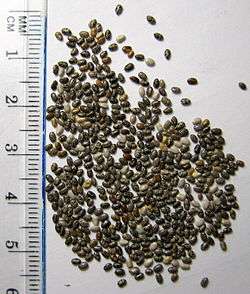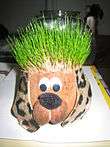Chia seed
Chia seeds are the edible seeds of Salvia hispanica, a flowering plant in the sage family (Lamiaceae) native to central and southern Mexico[1], or of the related Salvia columbariae of the southwestern United States and Mexico. Chia seeds are oval and gray with black and white spots, having a diameter around 1 millimetre (0.04 in). The seeds are hydrophilic, absorbing up to 12 times their weight in liquid when soaked and developing a mucilaginous coating that gives chia-based foods and beverages a distinctive gel texture.
Salvia_hispanica_group.jpg)
There is evidence that the crop was widely cultivated by the Aztecs in pre-Columbian times and was a staple food for Mesoamerican cultures. Chia seeds are cultivated on a small scale in their ancestral homeland of central Mexico and Guatemala and commercially throughout Central and South America.
Description
Salvia_hispanica_profile.jpg)

Typically, chia seeds are small flattened ovals measuring on average 2.1 mm × 1.3 mm × 0.8 mm (0.08 in × 0.05 in × 0.03 in), with an average weight of 1.3 mg (0.020 gr) per seed.[2] They are mottle-colored with brown, gray, black, and white. The seeds are hydrophilic, absorbing up to 12 times their weight in liquid when soaked; they develop a mucilaginous coating that giving a gel texture. Chia (or chian or chien) has mostly been identified as Salvia hispanica L. Other plants referred to as "chia" include "golden chia" (Salvia columbariae). The seeds of Salvia columbariae are used for food.
In the 21st century, chia is grown and consumed commercially in its native Mexico and Guatemala, as well as Bolivia, Argentina, Ecuador, Nicaragua, and Australia.[3] New patented varieties of chia have been developed in Kentucky for cultivation in northern latitudes of the United States.[4]
Seed yield varies depending on cultivars, mode of cultivation, and growing conditions by geographic region. For example, commercial fields in Argentina and Colombia vary in yield range from 450 to 1,250 kg/ha (400 to 1,120 lb/acre).[5][6] A small-scale study with three cultivars grown in the inter-Andean valleys of Ecuador produced yields up to 2,300 kg/ha (2,100 lb/acre), indicating that favorable growing environment and cultivar interacted to produce such high yields.[20] Genotype has a larger effect on yield than on protein content, oil content, fatty acid composition, or phenolic compounds, whereas high temperature reduces oil content and degree of unsaturation, and raises protein content.[7]
| Nutritional value per 100 g (3.5 oz) | |
|---|---|
| Energy | 486 kcal (2,030 kJ) |
42.1 g | |
| Dietary fiber | 34.4 g |
30.7 g | |
16.5 g | |
| Vitamins | Quantity %DV† |
| Vitamin A equiv. | 7% 54 μg |
| Thiamine (B1) | 54% 0.62 mg |
| Riboflavin (B2) | 14% 0.17 mg |
| Niacin (B3) | 59% 8.83 mg |
| Folate (B9) | 12% 49 μg |
| Vitamin C | 2% 1.6 mg |
| Vitamin E | 3% 0.5 mg |
| Minerals | Quantity %DV† |
| Calcium | 63% 631 mg |
| Iron | 59% 7.7 mg |
| Magnesium | 94% 335 mg |
| Manganese | 130% 2.72 mg |
| Phosphorus | 123% 860 mg |
| Potassium | 9% 407 mg |
| Zinc | 48% 4.6 mg |
| Other constituents | Quantity |
| Water | 5.8 g |
| |
| †Percentages are roughly approximated using US recommendations for adults. Source: USDA Nutrient Database | |
History
The 16th-century Codex Mendoza provides evidence that it was cultivated by the Aztec in pre-Columbian times, and economic historians say it may have been as important as maize as a food crop. It was given as an annual tribute by the people to the rulers in 21 of the 38 Aztec provincial states.[8] Chia seeds served as a staple food for the Nahuatl (Aztec) cultures. Jesuit chroniclers placed chia as the third-most important crop in the Aztec culture, behind only corn and beans, and ahead of amaranth. Offerings to the Aztec priesthood were often paid in chia seed.
Ground or whole chia seeds are used in Argentina, Bolivia, Guatemala, Mexico, and Paraguay for nutritious drinks and food.[9][10] Today, chia is cultivated on a small scale in its ancestral homeland of central Mexico and Guatemala, and commercially in Argentina, Bolivia, Ecuador, Guatemala, and Mexico.
Nutrition
Dried chia seeds contain 6% water, 42% carbohydrates, 16% protein, and 31% fat. In a 100-gram (3.5 oz) amount, chia seeds are a rich source (20% or more of the Daily Value, DV) of the B vitamins, thiamin and niacin (54% and 59% DV, respectively), and a moderate source of riboflavin (14% DV) and folate (12% DV). Several dietary minerals are in rich content, including calcium, iron, magnesium, manganese, phosphorus, and zinc (all more than 20% DV; see table).
The fatty acids of chia seed oil are mainly unsaturated, with linoleic acid (17–26% of total fat) and linolenic acid (50–57%) as the major fats.[11][12]
Research
Chia seeds are under preliminary research for their potential effects on health, but this work remains sparse and inconclusive.[13] In a 2015 systematic review, most studies were of poor quality and did not demonstrate significant effects of chia seed consumption on cardiovascular risk factors.[14] No evidence to date indicates consuming chia seeds has adverse effects on – or interacts with – prescription drugs.[13]
Uses
Food
Chia seeds may be sprinkled or ground up on top of other foods. Chia seeds can also be mixed into smoothies, breakfast cereals, energy bars, granola bars, yogurt, tortillas, and bread. They can be soaked in water and consumed directly or mixed with any kind of juice to make chia fresca[15] or with milk. Chia seed pudding, similar to tapioca pudding, is made with a type of milk, sweetener, and whole chia seeds. Chia seeds may also be ground and made into a gelatin-like substance or eaten raw.[16][17][18][19] The gel from ground seeds may be used to replace as much as 25% of the egg and oil content in cakes.[20]
In 2009, the European Union approved chia seeds as a novel food, allowing chia to be up to 5% of the total matter in bread products.[11]
Unlike flax seeds, and despite popular misconception, chia seeds are digestible whole and do not need to be ground. The human body absorbs the same nutrients from chia seeds regardless of whether the seeds are dry or soaked and regardless of whether they are whole or ground.

Chia pet
Joe Pedott created the Chia Pet in 1977 and marketed it widely after 1982. During the 1980s in the United States, the first substantial wave of chia seed sales was tied to chia pets, clay figures that serve as the base for a sticky paste of chia seeds. After the figures are watered, the seeds sprout into a form suggesting a fur covering.
About 500,000 chia pets were sold in the U.S. in 2007 as novelties or house plants.[21]
References
- "Salvia hispanica". Germplasm Resources Information Network (GRIN). Agricultural Research Service (ARS), United States Department of Agriculture (USDA). Retrieved 21 March 2012.
- Ixtaina, Vanesa Y.; Nolasco, Susana M.; Tomás, Mabel C. (November 2008). "Physical properties of chia (Salvia hispanica L.) seeds". Industrial Crops and Products. 28 (3): 286–293. doi:10.1016/j.indcrop.2008.03.009. ISSN 0926-6690.
- Dunn C (25 May 2015). "Is chia the next quinoa?". The Sydney Morning Herald. Retrieved 13 February 2016.
- Cheryl Kaiser, Matt Ernst (February 2016). "Chia" (PDF). University of Kentucky, College of Agriculture, Food and Environment, Center for Crop Diversification Crop Profile. Retrieved 13 February 2016.CS1 maint: uses authors parameter (link)
- Coates, Wayne; Ayerza, Ricardo (1998). "Commercial production of chia in Northwestern Argentina". Journal of the American Oil Chemists' Society. 75 (10): 1417–1420. doi:10.1007/s11746-998-0192-7.
- Coates, Wayne; Ricardo Ayerza (1996). "Production potential of chia in northwestern Argentina". Industrial Crops and Products. 5 (3): 229–233. doi:10.1016/0926-6690(96)89454-4.
- Ayerza (h), Ricardo; Wayne Coates (2009). "Influence of environment on growing period and yield, protein, oil and α-linolenic content of three chia (Salvia hispanica L.) selections". Industrial Crops and Products. 30 (2): 321–324. doi:10.1016/j.indcrop.2009.03.009. ISSN 0926-6690.
- Cahill, Joseph P. (2003). "Ethnobotany of Chia, Salvia hispanica L. (Lamiaceae)". Economic Botany. 57 (4): 604–618. doi:10.1663/0013-0001(2003)057[0604:EOCSHL]2.0.CO;2.CS1 maint: ref=harv (link)
- Kintzios, Spiridon E. (2000). Sage: The Genus Salvia. CRC Press. p. 17. ISBN 978-90-5823-005-8.
- Stephanie Strom (November 23, 2012). "30 Years After Chia Pets, Seeds Hit Food Aisles". The New York Times. Retrieved 26 November 2012.
Whole and ground chia seeds are being added to fruit drinks, snack foods and cereals and sold on their own to be baked into cookies and sprinkled on yogurt. ...
- (h), Ricardo Ayerza (1995-09-01). "Oil content and fatty acid composition of chia (Salvia hispanica L.) from five northwestern locations in Argentina". Journal of the American Oil Chemists' Society. 72 (9): 1079–1081. doi:10.1007/BF02660727. ISSN 0003-021X.
- USDA SR-21 Nutrient Data (2010). "Nutrition facts for dried chia seeds, one ounce". Conde Nast, Nutrition Data.
- Ulbricht C, et al. (2009). "Chia (Salvia hispanica): a systematic review by the natural standard research collaboration". Rev Recent Clin Trials. 4 (3): 168–74. doi:10.2174/157488709789957709. PMID 20028328.
- de Souza Ferreira C, et al. (2015). "Effect of chia seed (Salvia hispanica L.) consumption on cardiovascular risk factors in humans: a systematic review". Nutr Hosp. 32 (5): 1909–18. doi:10.3305/nh.2015.32.5.9394. PMID 26545644.
- "What are chia seeds and how do you cook with them?". Journal Sentinel. Milwaukee Journal Sentinel. May 30, 2017. Retrieved January 3, 2019.
- "Chewing Chia Packs A Super Punch". NPR. Retrieved 18 October 2012.
- Albergotti, Reed. "The NFL's Top Secret Seed". Wall Street Journal. Retrieved 19 October 2012.
- Trujillo-Hernández, C.A.; Rendón-Villalobos R.; Ortíz-Sánchez A.; Solorza-Feria J. (2012). "Formulation, physicochemical, nutritional and sensorial evaluation of corn tortillas supplemented with chia seed (Salvia hispanica L.)" (PDF). Czech Journal of Food Sciences. 30 (2): 118–125. doi:10.17221/393/2010-CJFS.
- Costantini, Lara; Lea Lukšič; Romina Molinari; Ivan Kreft; Giovanni Bonafaccia; Laura Manzi; Nicolò Merendino (2014). "Development of gluten-free bread using tartary buckwheat and chia flour rich in flavonoids and omega-3 fatty acids as ingredients". Food Chemistry. 165: 232–240. doi:10.1016/j.foodchem.2014.05.095. ISSN 0308-8146. PMID 25038671.
- Borneo R, Aguirre A, León AE (2010). "Chia (Salvia hispanica L) gel can be used as egg or oil replacer in cake formulations". J. Am. Diet. Assoc. 110 (6): 946–9. doi:10.1016/j.jada.2010.03.011. PMID 20497788.CS1 maint: uses authors parameter (link)
- Owen Edwards (December 2007). "Chia pet". Smithsonian Magazine. Retrieved 30 July 2018.